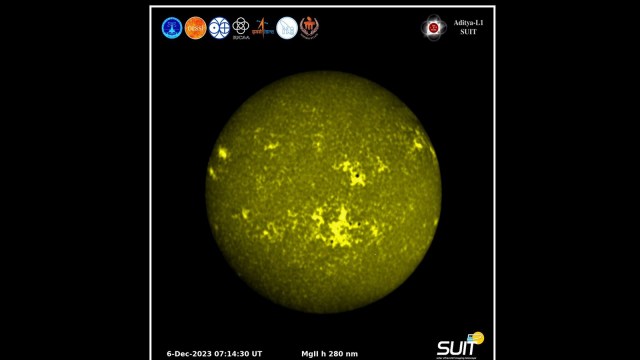India’s Aditya L-1 mission captures first-ever full-disk images of Sun
Sharing the images on social media platform X, formerly Twitter, ISRO wrote that the images " provide pioneering insights into the intricate details of the Sun's photosphere and chromosphere."
 The images include the first-ever full-disk representations of the Sun in wavelengths ranging from 200 to 400 nm. (X/@isro)
The images include the first-ever full-disk representations of the Sun in wavelengths ranging from 200 to 400 nm. (X/@isro)India’s Aditya L-1 mission has captured the first-ever full-disk images of the Sun in near ultraviolet wavelengths. The images, captured by the Solar Ultraviolet Imaging Telescope (SUIT) payload aboard ISRO’s first space-based mission to study the Sun, include the first-ever full-disk representations of the Sun in wavelengths ranging from 200 to 400 nm.
Sharing the images on social media platform X, ISRO wrote that the images “provide pioneering insights into the intricate details of the Sun’s photosphere and chromosphere”.
The Solar Ultraviolet Imaging Telescope, which is one of the seven payloads on the Aditya L-1, is meant to capture the UV image of the solar photosphere and chromosphere and to examine the variation in light energy emitted.
Aditya-L1 Mission:
The SUIT payload captures full-disk images of the Sun in near ultraviolet wavelengthsThe images include the first-ever full-disk representations of the Sun in wavelengths ranging from 200 to 400 nm.
They provide pioneering insights into the intricate details… pic.twitter.com/YBAYJ3YkUy
— ISRO (@isro) December 8, 2023
Prior to this, the Solar Wind Ion Spectrometer (SWIS), the second instrument in the Aditya Solar wind Particle Experiment (ASPEX) payload, started operations on December 2. The High Energy L1 Orbiting X-ray Spectrometer (HEL1OS) payload had captured the first High-Energy X-ray glimpse of Solar Flares last month.
Aditya L-1 was launched on September 2 from the Satish Dhawan Space Centre in Sriharikota. The mission’s main objective is to expand our knowledge of the Sun, and how its radiation, heat, flow of particles, and magnetic fields affect us.
The solar probe was carried into space by the Polar Satellite Launch Vehicle (PSLV), which is one of the most reliable and versatile workhorse rockets of ISRO. The PSLV will initially place the Aditya L-1 in a lower Earth orbit. Subsequently, the spacecraft’s orbit around the Earth will be raised multiple times before it is put on a path to a halo orbit around the L1 Lagrange point.
PSLV-XL can lift 1,750 kg of payloads to the sun-synchronous polar orbit (spacecraft here are synchronised to always be in the same ‘fixed’ position relative to the Sun), and much more — 3,800 kg — to a lower Earth orbit (normally located at an altitude of less than 1,000 km but could be as low as 160 km above the planet).







